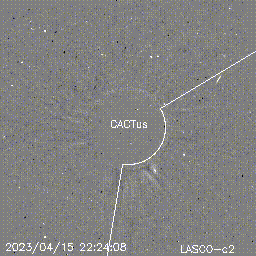Space Weather Alert - 19th April, 2023
What Has Happened?
A series of coronal mass ejections (CMEs) left the Sun on 15-April, all associated with filament eruptions. One of these eruptions produced a partial-halo CME at around 23:00 hours UT on 15-April, which is expected to arrive on 20-April or possibly late on 19-April.
The geomagnetic field has been disturbed by an earlier CME yesterday (18th), and there is a slight chance for a glancing blow from another during the day today (19th). Following the arrival of the partial-halo CME, the geomagnetic field is likely to become enhanced with a chance for some more significant activity, especially when combined with earlier CMEs.
Assuming clear, dark skies, there is a greater chance of seeing the aurora on the 19-April through to the 21-April. Those in Scotland, northern England and Northern Ireland have a better chance if the weather is favourable on those nights.
Sign-up to receive Geomagnetic Disturbance Alert emails.
Follow us on Twitter:
Follow @BGSauroraAlert for more occasional aurora alerts.
Follow @BGSspaceWeather for daily space weather forecasts.
Glossary
- BGS
- The British Geological Survey is a geoscience research centre that is part of UK Research and Innovation (UKRI) and affiliated to the Natural Environment Research Council (NERC).
- CME or Coronal Mass Ejection
- The eruption of a portion of the outer atmosphere of the Sun into space, caused by rapid changes in its magnetic field. Often occurs along with a solar flare.
- Filament Eruption
- An eruption of solar plasma (i.e. ions and electrons) associated with the upward movement of solar magnetic field lines into the corona. Filaments are usually dark against the bright solar disk but can appear bright (as 'erupting prominences') on the limbs of the Sun against the darkness of space. Filaments are often associated with CMEs



